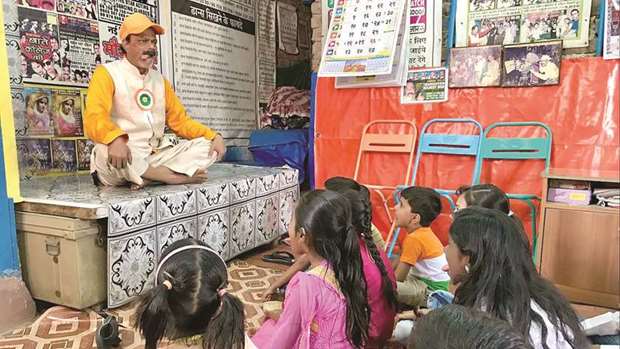There is an unlikely path to stardom in India’s city of dreams.
Turn right at a pair of goats picking through knee-high garbage, pass a new public toilet and look for a hand-painted sign marking a temple to Ganesh, the Hindu deity revered as a remover of obstacles.
Grab a conveniently hung rope for balance and ascend a narrow metal staircase that opens into a spacious, tin-roofed loft bedecked with movie posters. On a recent morning, a balding, rubber-faced man in his mid-50s, seated on a platform, was leading a group of students in an exercise. “I hate you,” he said, waving his hand as if discarding a piece of garbage.
The students repeated: “I hate you.”
“Ohh, how disgusting,” he said, wrinkling his nose.
“Ohh, how disgusting,” they spat in return.
Some in the class giggled. The youngest among them was 5 years old, and the English words sounded funny rolling off their tongues. But this was an acting class, and they had to be prepared to deliver any line.
The two dozen children shared the aspirations of millions of Indian movie fans: Each dreamed of a career in Bollywood, the behemoth film industry for which the seaside metropolis of Mumbai is known. None were deterred by the circumstances of their birth, in Dharavi, the sprawling mega-slum that lies in the heart of the city.
In the loft he built above his one-room house in Dharavi, the instructor, Baburao Laadsaheb, a sign painter by profession, runs a weekly course for slum children in acting, dancing, stage fighting, singing and other skills prized in India’s typically campy movie productions.
He teaches most of the children for free, offering a rare extracurricular activity in a city where organised sports and classes are usually reserved for those with money. None of his students arrive with any experience beyond mimicking the muscled actors and winsome actresses they know from posters or television.
Laadsaheb and others say that hundreds of his students have gone on to work in a business whose money and glamour are so distant from hardscrabble Dharavi that it is scarcely possible to imagine they occupy the same city.
Some of his students have worked in film and television as actors, dancers, models, cameramen, makeup artists, set designers and production assistants.
The walls of the loft are plastered with their photos, and dozens are catalogued at the back of Acting Master, a thick paperbound volume he authored as a manual for aspiring performers.
“Bollywood is a fascinating dream for kids here,” Laadsaheb said. “We grow up with movies. To dream of becoming a hero, that is common for everyone.”
But in Bollywood — like India at large — it’s not easy to make it from the bottom. Most of the leading stars in the world’s most prolific film industry are the offspring of successful actors and directors.
Laadsaheb knows none of his students are likely to become a household name, but he has had just enough brushes with fame to make the dream seem attainable.
He has supplied extras for a production featuring India’s most famous movie star, Amitabh Bachchan, and an upcoming film directed by Majid Majidi, an Oscar winner from Iran. He proudly recalled the day a decade ago when director Danny Boyle came to visit him while scouting locations for Slumdog Millionaire and hired him to find child actors.
“He was wearing shorts,” Laadsaheb said. “I remember he was struggling with the heat.”
Several of Laadsaheb’s students appeared in Boyle’s 2008 film, which went on to win the Academy Award for best picture — and put Dharavi on the map as a place of both extreme poverty and extreme dreams.
Before class on a recent morning, as a trio of young boys practised handstands on the vinyl flooring, Laadsaheb sat behind a small desk piled with newspaper clippings and a paperback textbook he wrote 22 years ago titled, “Acting Master Laadsaheb.”
He called over one of his pupils. Vedant Shirkhane, a skinny 8-year-old with an earnest grin, described with wide eyes how Laadsaheb recently helped him land a small role in a regional-language movie shot in Mumbai.
The part was not a stretch: He played a young troublemaker from a slum who was lifted out of poverty by the film’s protagonist.
“I got to sit in a BMW,” Vedant recalled. “They let me stay in a hotel room by myself and told me I could order whatever I wanted from the kitchen. So I ordered biscuits.”
At the end of the four-day shoot, Vedant earned Rs20,000 — about $320, more than a month’s salary for many in Dharavi — and handed the money to his father, a tailor.
“I really want to become a hero,” Vedant said, using the word that in India means movie star. “I have to learn how to act in different styles.”
Laadsaheb’s start in show business was more modest. He was scraping together a living making signs when a friend fell ill and asked him to take over a job as a painter on a movie set. He began getting more movie work, scouting for extras and, despite no formal dramatic training, even getting some bit parts in low-budget productions. In one Marathi-language movie, he played 12 different characters.
“I did all my life’s acting in that film,” he said. “But my focus is on teaching kids.”
Disappointed with the quality of coaching in the city, he launched his own school, Five-Star Acting and Dancing Classes. On a humid morning in January, under three whirring ceiling fans, he led students in a series of exaggerated facial expressions and gestures — including one of a mentally disabled person that should probably be retired — and demonstrated how to recoil from a stage punch, his moans eliciting laughs.
The children then took turns delivering the long, melodramatic soliloquies that are Bollywood’s stock in trade. Finally, Laadsaheb popped in a CD of Bollywood music. The students danced around with varying degrees of choreography, some bopping like kernels of popcorn in a microwave.
“Who knows if any one of them will be a star,” Laadsaheb said. “But acting requires the ability to speak in public and be confident. Those skills will help these children in any profession.”
Although a handful of older students pay a small fee, about $250 for six months of weekly lessons, Laadsaheb doesn’t take money from most Dharavi families. With his sign-painting business vanishing in the digital era, he and his wife — they have two adult children — survive mainly on his small casting commissions, often less than $200 per film.
He nevertheless harbours his own aspirations: to add air-conditioning in the loft, install a full-length mirror to help students practice their lines and build an additional floor to serve as a dormitory that might attract out-of-town pupils.
After the recent morning’s lesson, the students streamed downstairs and dispersed along the narrow dirt lane, where fresh laundry hung from windows and motorbikes were parked in neat rows.
Prahalad Ranadive, a 35-year-old construction worker, was waiting to pick up his son. Five-year-old Nikhil is a budding dancer, and at the end of class he had jumped on the small stage alongside two older boys when one of his favourite songs came on.
“We know that Laadsaheb has contacts, so we hope something good comes out of this course,” Ranadive said. “That way Nikhil won’t have to do the same job I have.” - Los Angeles Times/TNS
l Special correspondent Parth M.N. contributed to this report

IN CHARGE: Baburao Laadsaheb teaches an acting course for slum children in Mumbai.

